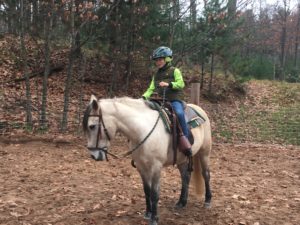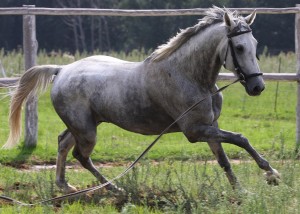
Propel Yourself to New Levels
Last month, I went to a 1-day riding clinic which was pretty much a waste of time, but did end up propelling me to new levels of riding. It wasn’t that the instruction was so good, in fact, I thought it was pretty bad and I came home feeling like I knew nothing. After a few days of thinking I that I was just a horrible horse trainer, I decided that was not true and I began to increase the amount of time I worked with my horse Ranger, the way that we have been working, using a style that has been working for us.
I have to say, I was a little harder on Ranger and he rose to the challenge. I rode him in a bit, which is a piece of metal in the mouth of the horse and if used properly is not a cruel device at all. A bit is used by 99% of people who ride horses, but there are alternatives. Because Ranger had a rough start when he was a little guy, and because he was pretty mistrusting, I had often used a “bitless bridle” for Ranger, something that seemed to put him at ease.
Ranger rose to the challenge of having a bit in his mouth again, and did well dropping his head, tucking his chin, and moving all the individual body parts I asked him to. After several days of intense training (by our standards), Ranger began to plateau. He was cooperative, but it seemed like he was being pushed.
Horse Personality
I like my horses “alive” and to have personality. I like them to be safe and obedient, but to still be who they are. I let Ranger have another go at the bitless bridle and boy did he seem to appreciate it. Ranger was gentler that he had been with the bit, calmer, and had more of what cowboys call “try”.
My kids have both started to ride Ranger and have figured out that they can control him without getting hurt or hurting him. My son, 8 years-old, actually just started riding for the first time on his own and he LOVED IT! This just made me so happy because I love horses and invest a lot of time and family resources into them. To share the joy I get, with my family, would mean the world to me.
Lessons Learned
So here is what I learned this summer and how it can be applied to any situation in life. There will be times where some well-meaning soul will try and teach you something and tell you you’re doing it all wrong. Take what you can from these people, but never stop trusting in yourself and using what works for you. It is important to get outside advice, but I know from life coaching that as coaches we are not supposed tell someone how to do something, but rather help them on a journey of self-exploration. Look inward to judge yourself and see if you can do it better, but believe in yourself and trust in your talents.
Next, look to your team for feedback and make sure you are taking care of them the way they want to be taken care of. Sometimes there are external pressures for how you should treat your team, what they should be allowed and what kind of benefits they should get. However, if you want to really invest in your team, take care of them they by asking them what they need. A team member will tell you how they like to work. If you make a working environment a pleasurable place to work and build a trusting relationship, you will get a 100% return on your investment.
So there it is, a little tip from a Fall Northwoods horse training session. Trust in your ability and take care of your team. Next thing you know, you will be the kind of leader you have always wanted to be.
Keep leading,
Rad

It has taken me a long time to get to the intermediate level of horsemanship; about 14 years. During that time I have read a lot about horses and horse training. I have watched a lot of videos. I have owned 10 different horses (I know that is ridiculous), and I have even done some training with other people’s horses. I still have a lot to learn, a ton! I know that there is way more for me to learn than I know. I am not even halfway there. I haven’t even scratched the surface. I have, however, learned a great deal.
Greatest Teachers
Horses themselves have been my greatest teachers. These magnificent animals are very honest and true. Once you learn how to read them, they share a language and it is earnest and pure. They don’t always tell you what you want to hear, but they don’t try and deceive you by hiding their feelings.
Horses operate in their own world, with their own rules, much like any other species I have studied closely, and each, having their own secrets to share with us. I have been open to learning about their world, right from the horse’s mouth if you will. I think I have done well with horses in part because of my background in ecology and conservation and the fact that I approach horses much as I approach wildlife species. I understand that it is not all about me, about us, but rather often about the horse and what they need.
Leadership Skills
Spending time with horses has actually been a great way to study leadership. Through watching these powerful animals and getting them to trust me enough to allow me to ride them, I have learned a lot about what a leader is and how to summon up leadership ability that may initially seem impossible to manifest. There are some really great lessons to be learned about being a leader from working with horses. I would make a case for those lessons being somewhat essential to people who hope to, or even already do, hold the prestigious title of Leader.
In the horse world you often hear things like, “To be a good horseman, your horse needs to understand that you are dominant.” You hear that the ultimate goal is control at every second. You hear that you must make the horse respect you. Is this true?
There are parts that are true, but I think many equestrians take this too far and lose the ability to truly bond with a horse. Others don’t believe it enough and soon find out that they are not yet worthy of leading a horse. It seems to me many leaders in human life are wrestling with the same challenges. Whether it be in an office, on a job site, in a warehouse, or even at home parenting, I think many out there are too focused on dominating, controlling, and demanding respect. Others have no idea how to earn this respect.
Lessons Learned
Although many of the equestrian teachers I follow will argue that what we want with our horses is control, I think that is only true to a point. I do want to decide what direction we go, the gate we travel in, and even the speed, more or less. But I don’t want to control the horse’s every move. If I did want total control, I would ride a bicycle instead of a horse. I get on the horse and give it a job. I don’t micromanage this job, but rather ride until the next big decision needs to be made. I don’t sit up there and say step, step, step, step. I just say “let’s go over there” and let the horse do its thing. I may steer around this object or that, but I trust the horse to do its job much of the time.
Leaders have to learn this lesson. When you are working with someone in a leadership position, it is very important not to micromanage. For one thing, it drives people crazy. For another thing, it is a poor use of your time. When putting together a good team or even just having one employee, one needs to realize that they have their own strengths, their own style of doing things. It is important to direct the task, but not direct every step of the way.
This is just one of the many ways horses can teach us about leadership. There is nothing like actually working with a horse to humble you and make you realize how much there is to learn. At the same time there is nothing like working with a horse to invigorate you and make you see your full leadership potential. When you are the one giving assignments to a thousand pound animal and it is actually looking to you for direction, things get real, fast. It is inspiring to find out that you can rise to this occasion, and if done right, build a relationship where you are seen by the horse as both gentle and caring, but also powerful and worthy of the greatest amount of authority. They would literally trust you with their lives. I know I have implemented the lessons learned from horses in my life, in the leadership positions I’ve had. So… maybe I have not been wasting my time horsing around.
All the best,
Rad
Rad Watkins and the Animal Leadership LLC team are always learning what we can from the animal kingdom and applying it to our own lives. Learning lessons from the wild can help you unlock a better version of yourself. Browse our main website to learn more about the writings and motivational seminars developed by Rad Watkins.
]]>